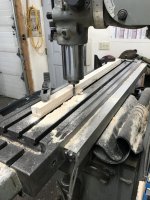So here we are, getting down to the end. A lot of sanding remains but nothing else except the tip protector will be added. I did some side by side comparing and here’s what i learned. The pattern weighs 40oz. the carbon paddle weighs 32oz.; not a tremendous weight savings but the balance point is enough different that it no longer has a “too heavy blade feel”. When all the sanding’s done i may loose another wee bit but not enough to be note worthy. This paddle has 2 layers of glass, a layer of carbon, a layer of carbon/kevlar over the blade and a full carbon sleeve. This is a big paddle, 65 inches long, large dia shaft etc and im happy with the weight. It’s also robust and capable of more than propelling the canoe, id not go so far as to say it could double as a peavy but it is quite stout. For this fishery the paddle will see service as a paddle, a pole; for pushing off heavy mud banks and thru a small rocky section and possible to “repel boarders”!

Over balsa, i believe one full layer of kevlar and one layer of carbon would give equal strength and a much lighter weight. So what i have here is a “ray special blade“, an approximation of an Aleutian asymmetrical shaft and a north woods grip, in other words; a collection of compromise. I like the shaft girth and the grip section real well and will use them again, the narrow blade is suppose to be gentler to my shoulders? Time will tell!
What else did i learn? The spine on the Aleutian blades is suppose to re-direct water and reduce drip as well as prevent chatter (with very narrow blades). Mine should have been added before the last layer as it pretty much went away under the 3 previous layers And unless i see a strong drip deterrent, it will go away next time.
I have enough leftovers to make another paddle and for that i will use balsa instead of foam for the core. I can work it into thinner sections than the foam and will end with something more svelte. The next one will have a shorter/wider blade, better suited to the numerous shallow streams around here. This one will function fine used in the intended tide water fishery. At some point i’ll need one of @lowangle al’s quivers for a two paddle arsenal!
Once it’s done done i’ll post the final pictures, im still a couple days away.




































